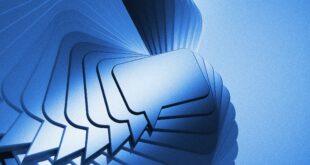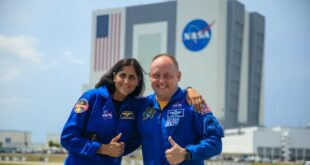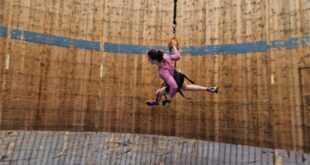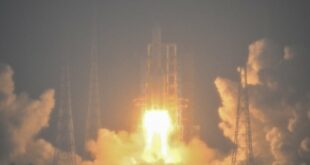Astronauts were forced to repair the Hubble telescope after a flaw was discovered in its mirror

Thirty years ago, an 11-day space shuttle mission involving seven veteran astronauts performed the first servicing mission to correct the Hubble Space Telescope's blurred vision.
The unprecedented flight involved five spacewalks and would not have been possible without the assistance of the shuttle's robotic Canadarm.
The multi-billion dollar Hubble Space Telescope was a crown jewel of NASA's space program. At the time, it was the largest and most capable astronomical observatory in orbit, with a clear view of the universe unobstructed by the Earth's atmosphere.
But soon after it was launched in 1990, it turned into a huge embarrassment for the space agency when the first images of distant stars and galaxies from orbit were fuzzy images instead of the crystal clear pictures that were expected.

An error in the grinding process gave the 2.4-metre primary mirror the wrong shape and it was unable to focus images clearly.
The phenomenon, known as spherical aberration, was caused by the edges of the mirror being too flat. Astronomers were extremely disappointed and concerned that their new instrument might not be able to perform useful science.
However, there were two signs of hope. First, the flaw in the mirror was very precise, with the edges off by only 0.003 millimetres — something like 1/50th the width of a human hair.
The second bit of good news was that the telescope had been designed with modular instruments that could be unplugged and replaced by astronauts using the space shuttle.

So plans were put in place to design a set of corrective optics using small mirrors with precise shapes that would be placed in front of the cameras. Those mirrors would remove the flaw in the main mirror and give Hubble clear vision. It was the equivalent to a nearsighted person putting on a pair of glasses to see distant objects.
To carry out the repair mission, the crew from space shuttle Endeavour had to rendezvous with Hubble and conduct the repairs in orbit. The Canadarm, mounted in the shuttle's cargo bay, was an essential tool for every step of the repair.
The first step was to fly the shuttle to within 10 metres of the 12-tonne orbiting telescope, which is the size of a school bus. Astronauts then used Canadarm to reach out and grab onto the telescope and haul it down to a mounting bracket on the shuttle's cargo bay.
The repair took place over five spacewalks, with astronauts going out in pairs — one of them floating freely and the other perched on the end of the arm. A crew member inside the shuttle controlled the arm like a cherry picker, moving the astronaut to whatever position they needed to be in to perform the repairs.
They installed two new instruments designed to compensate for the flawed mirror. The new optical device called COSTAR (Corrective Optics Space Telescope Axial Replacement) was the size of a phone booth and the new Wide Field and Planetary Camera 2 (WFPC2), the size of a baby grand piano.

To move these big pieces in and out of the telescope, the astronaut anchored to the arm would grab onwhile the arm did the motions necessary to manipulate these large objects in the weightlessness of space with millimetre precision.
In addition to the new optics and an improved camera, Hubble's solar panels and gyroscopes were also replaced. By the end of the mission, the telescope was in better condition than when it was originally designed.
With repairs complete, the final task was to use Canadarm to lift Hubble out of the shuttle cargo bay and release it back into space. This time, when the telescope's eyes were opened, astronomers were delighted by the clarity of the new images. The repair was a complete success and Hubble introduced a new era of astronomy.

Four more repair missions would be flown over the following decades, performing maintenance and improving instruments allowing the iconic telescope to continue operating right up to this day and hopefully for years to come. The wise decision to design Hubble with repairs in mind has certainly paid off.
Fortunately, an emergency rescue was not necessary — or even possible — with the new James Webb Space Telescope. It's larger and more capable than Hubble, but is positioned 1.5 million kilometres from Earth, far beyond the reach of any repair crew.
That is why the launch of Webb was such a nail-biter. The complex instrument had to unfold like a flower in space, align its segmented mirror, open a sunshade and cool down to almost absolute zero before it could operate.
But thanks to good engineering, both telescopes now complement each other, extending the human ability to not only see the universe more clearly, but look back to the very beginning of time.
*****
Credit belongs to : www.cbc.ca
 MaharlikaNews | Canada Leading Online Filipino Newspaper Portal The No. 1 most engaged information website for Filipino – Canadian in Canada. MaharlikaNews.com received almost a quarter a million visitors in 2020.
MaharlikaNews | Canada Leading Online Filipino Newspaper Portal The No. 1 most engaged information website for Filipino – Canadian in Canada. MaharlikaNews.com received almost a quarter a million visitors in 2020.







